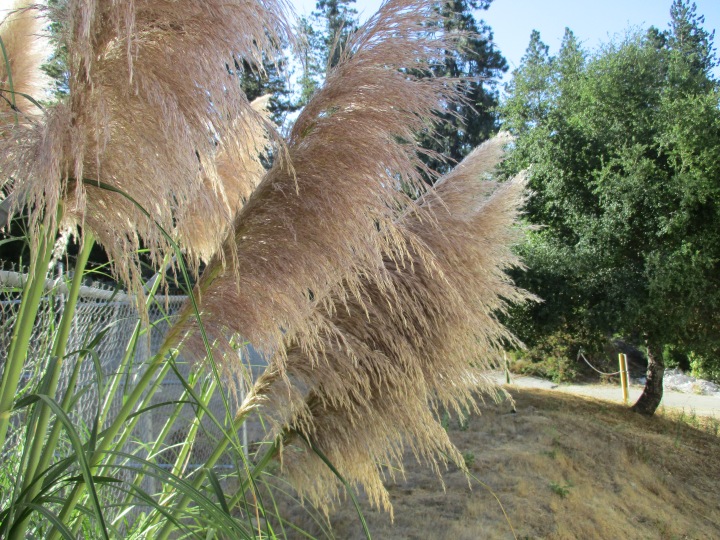 It is known by a few different common names, including ‘Andean pampas grass’, ‘purple pampas grass’, and simply ‘pampas grass’. ‘Andean pampas grass’ sounds almost like an oxymoron, since the Andes Mountains are in a separate region to the west of the pampas region of Uruguay and eastern Argentina. ‘Purple pampas grass’ is even sillier, since it is devoid of any purple.
It is known by a few different common names, including ‘Andean pampas grass’, ‘purple pampas grass’, and simply ‘pampas grass’. ‘Andean pampas grass’ sounds almost like an oxymoron, since the Andes Mountains are in a separate region to the west of the pampas region of Uruguay and eastern Argentina. ‘Purple pampas grass’ is even sillier, since it is devoid of any purple.
I know it simply as ‘papas grass’. That is just how I learned it. The problem with this common name is that it is the same common name of Cortaderia selloana and its cultivars, which is a distinct species that is, on rare occasion, planted intentionally in landscapes. Cortaderia jubata is one of the most aggressively invasive of exotic species on the West Coast, so is not planted.
Cortaderia selloana is safe to plant because it is ‘supposedly’ sterile, so can not naturalize. Technically though, it is not really sterile, but merely exclusively female, without male flower parts for pollination. It reproduces by apomixis, which is a fancy way of saying that it produces viable seed without pollination. No one has bothered to explain why that makes it any less invasive.
Cortaderia jubata reproduces by apomixis too, but makes much more of problem with it. It is very prolific with its unpollinated seed! To make matters worse, it will hybridize freely with Cortaderia selloana if it gets the chance. How does that even work?! Pollen is needed for that sort of hanky panky! Nonetheless, the hybrids are almost as aggressive as Cortadera jubata is!
I just don’t trust any of them. Cortaderia selloana cultivars can work well in large landscapes in urban areas, where they can not escape into the wild. For rural or suburban landscapes that are near wildlands, there are plenty of other less invasive options.
For awhile, if you can imagine, we were even planting this up here in the “frozen wilds” of Connecticut. It would winter over for a year or two–& then we would get a “real” winter and that would be the end of that.
Garden centers used to sell all sorts of marginally hardy plants. I know mine only did so with lots of caveats–but I think people get tired of replanting every couple of years.
I too would grow a bunch of things–in containers–that I used to shelter in my garage every year. Then one winter even that got too cold and that was the end of that.
For us, nature solves–or creates, depending on your outlook– a lot of problems.
Karla
LikeLiked by 1 person
Dead pampas grass are probably better than live pampas grass. I would not mind planting them if I knew that they would not naturalize. They certainly are pretty.
LikeLike
Blech on Pampas Grass!!
LikeLiked by 1 person
Yup! I tried to be polite.
LikeLike
Good job.. I had a friend banned from Facebook for WT?. But the F word is okay, go figure.
LikeLiked by 1 person
Oh, that was not my concern. I just did not want to offend anyone who likes pampas grass.
LikeLike
You think someone likes it?
LikeLiked by 1 person
Oh yes. A few people really like it. This one is in front of my colleague Brent’s house. https://santamariatimes.com/lifestyles/columnist/tony_tomeo/highlight-dwarf-pampas-grass/article_554f59e7-2fd1-5451-ac33-3b4df81929d6.html
LikeLike
Ugh
LikeLiked by 1 person
Reblogged this on Tony Tomeo and commented:
This is the Pampas grass that give all Pampas grass a bad reputation.
LikeLike